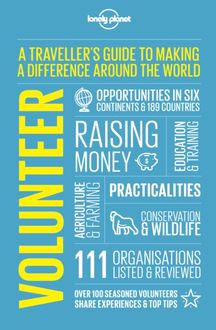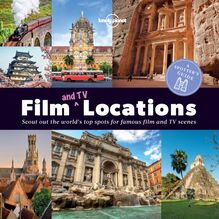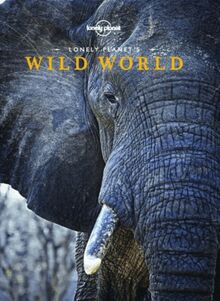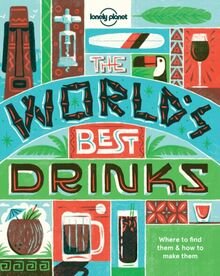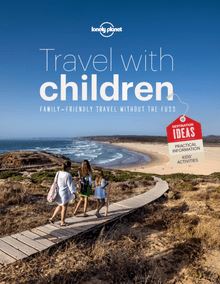Spotter's Guide to Film (and TV) Locations , livre ebook
108
pages
English
Ebooks
2017
Vous pourrez modifier la taille du texte de cet ouvrage
Obtenez un accès à la bibliothèque pour le consulter en ligne En savoir plus
Découvre YouScribe en t'inscrivant gratuitement
Découvre YouScribe en t'inscrivant gratuitement
108
pages
English
Ebooks
2017
Vous pourrez modifier la taille du texte de cet ouvrage
Obtenez un accès à la bibliothèque pour le consulter en ligne En savoir plus
Publié par
Date de parution
01 avril 2017
Nombre de lectures
2
EAN13
9781787010895
Langue
English
Poids de l'ouvrage
17 Mo
Publié par
Date de parution
01 avril 2017
Nombre de lectures
2
EAN13
9781787010895
Langue
English
Poids de l'ouvrage
17 Mo
Film and TV Locations
Scout out the world’s top spots for famous film and TV scenes
Ladies and gentlemen, welcome to the ultimate movie book.
The movies take you places: cinema is a mode of transport. In just 90 minutes, you can be whisked all the way around the globe – perhaps with a dotted red line marking your progress on a map as you go. Some films take you even farther, out of this world and to other galaxies far, far away. As Roman Polanski put it, a film hasn’t done its job correctly unless you forgot you were sitting in a theatre.
What’s great is that the converse is often true: there are some places that can transport you into the world of a movie. If you want to feel like James Bond, try going to James Bond Island (page 10). In a Holly Golightly mood? Have a danish pastry and some coffee outside Tiffany’s in Manhattan (page 62). Or want to feel like Rocky? Then run up the steps to the Philadelphia Museum (page 24) and put your hands in the air like a champ when you get to the top.
This book is about the real-world places that provided the backdrops and settings for some of our most memorable collective dreams. Some of these locations played themselves and others were dressed up to look like somewhere else. But they all added texture and colour and weight to the visions of our best TV- and film-makers.
Who needs CGI when the real world looks as fabulous and varied as this?
The Martian
N 29° 32’ 3.5052’’ E 35° 24’ 29.1312’’
2015
Wadi Rum, Jordan
Despite the support and involvement of NASA, it wasn’t practical for Ridley Scott to shoot pro-science Robinson Crusoe story The Martian on Mars, so he returned to the next best thing: Wadi Rum in Jordan, where he’d also shot scenes set on an alien planet in Prometheus (2012).
Wadi Rum is also known as ‘the Valley of the Moon’ but ‘the Valley of Mars’ might be more apt. Red Planet (2000) and the Last Days on Mars (2013) were both filmed there, too. As were key scenes in Lawrence of Arabia (1962).
©JOE WINDSOR-WILLIAMS/LONELY PLANET
The Motorcycle Diaries
S 13° 9’ 47.3076’’ W 72° 32’ 41.8668’’
2004
Machu Picchu, Peru
In 1952, during a year-long road trip through South America on a Norton motorcycle, the 23-year-old medical student and future revolutionary Ernesto ‘Che’ Guevara had a political awakening. In Walter Salles’s beautifully photographed movie version of events, young Che is profoundly moved by the 15th-century Incan mountaintop city of Machu Picchu, and wonders aloud about the progressive utopia South America might have become if not for the Spanish conquistadors. Human sacrifices notwithstanding.
©MARTIN BISOF/500PX
RoboCop
N 32° 46’ 34.5144’’ W 96° 47’ 48.8832’’
1988
Dallas City Hall, Texas, USA
The great cyberpunk sci-fi cinema of the 1980s envisaged dehumanised, depersonalised worlds. For example, RoboCop took IM Pei’s design for Dallas City Hall, a bold modernist inverted pyramid he intended ‘to convey an image of the people’, and turned it into the headquarters of OCP, the ruthless and unfeeling private corporation that supplies law enforcement in a dystopian future. Still, cool robots!
©JDONOVAN REESE/GETTY IMAGES
Roman Holiday
N 41° 53’ 17.106’’ E 12° 28’ 53.8932’’
1953
Santa Maria in Cosmedin, Rome, Italy
Legend has it that the Bocca della Verità – an ancient Roman marble manhole cover which is now in the portico of the church of Santa Maria in Cosmedin – acts like a kind of primitive lie detector. It’s probably nonsense. But it is true that you can pinpoint the exact moment that the world fell in love with Audrey Hepburn to the supposedly unscripted bit in Roman Holiday when she reacts to Gregory Peck sticking his hand in its mouth.
© JAMES HARDY/GETTY IMAGES
Marie Antoinette
N 48° 48’ 17.514’’ E 2° 7’ 13.278’’
2006
Palace of Versailles, France
Perhaps because she intended a more sympathetic portrait of the cake-eating queen than most, or perhaps simply because she films beautiful things so beautifully, Sofia Coppola was given the keys to the castle: that is, unprecedented access to any of the Palace of Versailles’s 700 rooms that she wished to film in.
FREDERIC LEGRAND - COMEO/SHUTTERSTOCK.COM
The Man With the Golden Gun
N 8° 16’ 28.2828’’ E 98° 30’ 4.4136’’
1974
James Bond Island (Khao Phing Kan), Thailand
Khao Phing Kan rarely goes by its given name, and has been locally known as James Bond Island ever since Christopher Lee’s supervillain Scaramanga hid his ‘solex agitator’ in the limestone karst tower off its shore. Why Scaramanga also built a funhouse and hall of mirrors on the island is anyone’s guess, but it’s best not to question the logic of the Roger Moore–era Bond films too closely.
©MUSTANG_79/GETTY IMAGES/ISTOCKPHOTO
Into the Wild
N 33° 15’ 14.796’’ W 115° 28’ 21.3168’’
2007
Salvation Mountain, Colorado Desert, California, USA
Christopher McCandless was a young man who rechristened himself Alexander Supertramp and went a-wandering in the American wilderness in search off Huck Finn–type adventures and Thoreauvian transcendental experience. Leonard Knight was an outsider artist who spent the last 30 years of his life on the creation of a painted mountain emblazoned with messages about God, love and salvation. It makes total sense that the latter would feature in Sean Penn’s heartfelt biographical film about the former.
©SIMON WILLMS/GETTY IMAGES
The Lost Boys
N 36° 57’ 54.6012’’ W 122° 0’ 59.7816’’
1987
Santa Cruz Boardwalk, California, USA
With all those flashing lights and thrill-seekers, all that motion and excitement, is it any wonder that a small-town Californian boardwalk after dark might act as a beacon for young men with motorbikes and leather jackets, punky haircuts, pointy teeth and lots of rock-and-roll, stay-up-all-night attitude.
It’s not a major cause for alarm, unless it seems like your older brother has become one of them. Or like Mom might find out.
©MALYN/500PX
The Shining
N 45° 19’ 50.3436’’ W 121° 42’ 47.1924’’
1980
Timberline Lodge, Mount Hood, Oregon, USA
Here is the exterior of the Overlook, the hotel in which winter caretaker Jack Torrence loses his mind in one of the most remarkable horror movies ever made. Sadly if you visit, you won’t get to see the ‘70s patterned carpets that are the scariest thing in the film, as the interior scenes were shot on enormous, exquisitely detailed sets built in Elstree studios in the UK.
© DON LOWE/GETTY IMAGES
The Lives of Others
N 52° 32’ 30.7752’’ E 13° 30’ 0.9036’’
2006
Berlin-Hohenschönhausen Memorial, Berlin, Germany
Although it didn’t officially exist, Hohenschönhausen prison is where the Stasi did its interrogating, torturing and imprisoning of East German citizens during the period depicted in Florian Henckel von Donnersmarck’s evocative political thriller The Lives of Others . Scenes were set here but the interiors were shot in a film studio.
Now home to a museum, it’s a memorial to the era and a powerful reminder of the horrors that can result from the combination of political paranoia and state surveillance. As is the film.
©NOVARC IMAGES/ALAMY
Pan’s Labyrinth
N 41° 18’ 0.2232’’ W 0° 44’ 51.4428’’
2006
Belchite, Zaragoza, Spain
Guillermo del Toro’s dark fairytale, about a girl who enters a fantasy world to escape the reality of life as the new stepdaughter of a fascist army officer after the Spanish Civil War, is full of strange sights and special effects. But this place, where her journey between worlds begins, is real: the ruins of an entire town that was destroyed by the war, then left by Franco as a symbol of his victory, and eventually reclaimed as a memorial to the dead.
©ÁLVARO MINGUITO/500PX
Brokeback Mountain
N 51° 4’ 13.548’’ W 115° 21’ 32.9832’’
2005
Kananaskis Country, Alberta, Canada
Not many films have a better feel for a place, or for how a landscape can dramatically sculpt the lives of the people living in it, than Brokeback Mountain has for the small towns and the rugged countryside of 1960s and 1970s Wyoming. And this is despite the fact that the film was shot 965km further up the Rocky mountain range, in Alberta, Canada.
©LEN SALTIEL/500PX
Jaws
N 41° 22’ 51.0888’’ W 70° 38’ 46.9716’’
1975
Martha’s Vineyard, Massachusetts, USA
Derr-derr … Derr-derr … Der-der der-der … Der-der-der-der-der-der-de-de-de-de …
In 1975, the swanky Cape Cod island resort Martha’s Vineyard played Amity Island: a beach community that was terrorised by a big, mean great white shark that developed a taste for tender young human flesh, could chew its way through the hull of a fishing boat, and had its own ominous theme tune. And to this day, people are scared to go in the water.



